
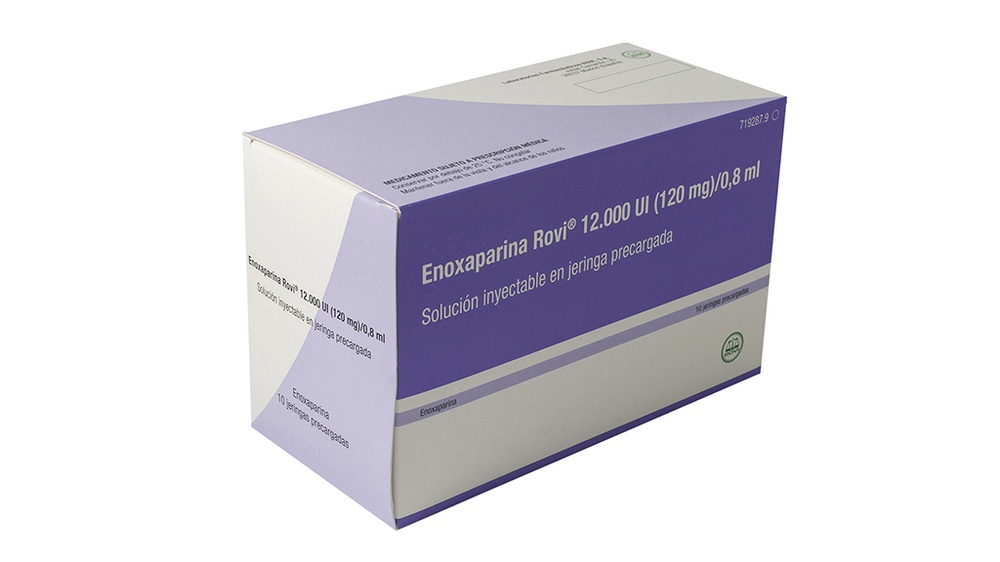
ЭНОКСАПАРИН РОВИ 12 000 МЕ (120 мг)/0,8 мл РАСТВОР ДЛЯ ИНЪЕКЦИЙ В ПРЕДНАПОЛНЕННОМ ШПРИЦЕ


Инструкция по применению ЭНОКСАПАРИН РОВИ 12 000 МЕ (120 мг)/0,8 мл РАСТВОР ДЛЯ ИНЪЕКЦИЙ В ПРЕДНАПОЛНЕННОМ ШПРИЦЕ
Введение
Инструкция: информация для пользователя
Эноксапарин Рови 12 000 МЕ (120 мг)/0,8 мл раствор для инъекций в предварительно заполненном шприце
эноксапарин натрия
Прочитайте внимательно всю инструкцию перед началом использования этого лекарства, поскольку она содержит важную информацию для вас.
- Сохраните эту инструкцию, поскольку вам может потребоваться перечитать ее.
- Если у вас есть какие-либо вопросы, проконсультируйтесь с вашим врачом, фармацевтом или медсестрой.
- Это лекарство было назначено только вам и не должно быть передано другим людям, даже если они имеют те же симптомы, что и вы, поскольку оно может нанести им вред.
- Если вы испытываете побочные эффекты, проконсультируйтесь с вашим врачом или фармацевтом, даже если это побочные эффекты, которые не указаны в этой инструкции. См. раздел 4.
Содержание инструкции
- Что такое Эноксапарин Рови и для чего он используется
- Что вам нужно знать перед началом использования Эноксапарина Рови
- Как использовать Эноксапарин Рови
- Возможные побочные эффекты
- Хранение Эноксапарина Рови
- Содержание упаковки и дополнительная информация
1. Что такое Эноксапарин Рови и для чего он используется
Эноксапарин Рови содержит активное вещество эноксапарин натрия, которое является низкомолекулярной гепариной (НМГ).
Эноксапарин Рови действует двумя способами:
- Предотвращая увеличение размера уже существующих血яных сгустков. Это помогает вашему организму разрушить их и предотвратить дальнейший вред.
- Прерывая образование новых сгустков в крови.
Эноксапарин Рови может быть использован для:
- Лечения сгустков крови.
- Предотвращения образования сгустков крови в следующих ситуациях:
- До и после хирургической операции.
- Когда у вас есть острая болезнь и вы должны ограничить свою подвижность.
- Если у вас был сгусток крови из-за рака, чтобы предотвратить образование новых сгустков.
- Когда у вас есть нестабильная стенокардия (болезнь, при которой сердцу не хватает крови).
- После инфаркта миокарда.
- Предотвращения образования сгустков крови в трубках аппарата для диализа (который используется у людей с тяжелыми проблемами почек).
2. Что вам нужно знать перед началом использования Эноксапарина Рови
Не используйте Эноксапарин Рови
- Если вы аллергичны к эноксапарину натрия или любому другому компоненту этого лекарства (перечисленному в разделе 6). Признаки аллергической реакции включают: сыпь, проблемы с глотанием или дыханием, отек губ, лица, горла или языка.
- Если вы аллергичны к гепарину или другим низкомолекулярным гепаринам, таким как надропарин, тинзапарин или далтепарин.
- Если у вас была реакция на гепарин, которая привела к значительному снижению количества тромбоцитов (тромбоцитопении) в течение последних 100 дней или если у вас есть антитела к эноксапарину в крови.
- Если у вас есть сильное кровотечение или заболевания с высоким риском кровотечения (например, язва желудка, недавняя операция на глазах или мозге), включая недавний геморрагический инсульт.
- Если вы используете Эноксапарин Рови для лечения сгустков крови и собираетесь пройти спинальную или эпидуральную анестезию или люмбальную пункцию в течение 24 часов.
Предостережения и меры предосторожности
Эноксапарин Рови не должен быть заменен другими лекарствами из группы низкомолекулярных гепаринов. Это связано с тем, что они не идентичны и не имеют одинаковой активности или инструкций по применению.
Проконсультируйтесь с вашим врачом или фармацевтом перед началом использования Эноксапарина Рови, если:
- у вас когда-либо была реакция на гепарин, которая привела к значительному снижению количества тромбоцитов
- вы собираетесь пройти спинальную или люмбальную анестезию или пункцию (см. «Хирургические операции и анестезия»): должно быть соблюдено время между использованием Эноксапарина Рови и проведением этой процедуры
- у вас установлен кардиостимулятор
- у вас есть эндокардит (инфекция внутренней оболочки сердца)
- у вас есть язва желудка
- у вас недавно был инсульт (геморрагический инсульт)
- у вас высокое кровяное давление
- у вас диабет или проблемы с кровеносными сосудами глаз, вызванные диабетом (ретинопатия)
- у вас недавно была операция на глазах или мозге
- вы пожилой человек (старше 65 лет) и особенно если вам больше 75 лет
- у вас проблемы с почками
- у вас проблемы с печенью
- у вас очень низкий вес или избыточный вес
- у вас высокий уровень калия в крови (что может быть обнаружено с помощью анализа крови)
- вы сейчас используете лекарства, которые влияют на кровотечение (см. ниже - Использование Эноксапарина Рови с другими лекарствами).
Вам может потребоваться сдать анализ крови перед началом использования этого лекарства и во время его использования; это необходимо для проверки количества тромбоцитов и уровня калия в крови.
Дети и подростки
Безопасность и эффективность эноксапарина не были оценены у детей или подростков.
Использование Эноксапарина Рови с другими лекарствами
Сообщите вашему врачу или фармацевту, если вы используете, недавно использовали или можете использовать любое другое лекарство.
- Варфарин - используется для снижения свертываемости крови
- Аспирин (также известный как ацетилсалициловая кислота или АСК), клопидогрел или другие лекарства, используемые для предотвращения образования сгустков крови (см. также раздел 3, «Смена антикоагулянтной терапии»)
- Декстран - используется как заменитель крови
- Ибупрофен, диклофенак, кеторолак и другие лекарства, известные как нестероидные противовоспалительные препараты, используемые для лечения боли и воспаления при артрите и других заболеваниях
- Преднизолон, дексаметазон и другие лекарства, используемые для лечения астмы, ревматоидного артрита и других заболеваний
- Лекарства, которые увеличивают уровень калия в крови, такие как калийные соли, диуретики и некоторые лекарства для лечения сердечных проблем.
Хирургические операции и анестезия
Если вам предстоит люмбальная пункция или вы собираетесь пройти хирургическую операцию, при которой будет использована спинальная или эпидуральная анестезия, сообщите вашему врачу, что вы используете Эноксапарин Рови. См. «Использование Эноксапарина Рови с другими лекарствами». Также сообщите вашему врачу, если у вас есть проблемы с позвоночником или если вы ранее проходили операцию на позвоночнике.
Беременность и лактация
Если вы беременны, думаете, что можете быть беременной или планируете стать беременной, проконсультируйтесь с вашим врачом или фармацевтом перед использованием этого лекарства.
Если вы беременны и у вас установлен механический клапан сердца, у вас может быть более высокий риск образования сгустков крови. Ваш врач обсудит это с вами.
Если вы кормите грудью или планируете кормить грудью, проконсультируйтесь с вашим врачом перед использованием этого лекарства.
Вождение и использование машин
Эноксапарин Рови не влияет на способность управлять транспортными средствами и работать с машинами.
Рекомендуется, чтобы медицинский работник записал название торговой марки и номер партии продукта, который вы используете.
Эноксапарин Рови содержит натрий
Это лекарство содержит менее 23 мг натрия (1 ммоль) на дозу; это означает, что оно практически «не содержит натрия».
3. Как использовать Эноксапарин Рови
Следуйте точно инструкциям по применению этого препарата, указанным вашим врачом или фармацевтом. В случае сомнений проконсультируйтесь с вашим врачом или фармацевтом.
Применение препарата
- Обычно ваш врач или медсестра вводят Эноксапарин Рови. Это связано с тем, что его необходимо вводить путем инъекции.
- Когда вы вернетесь домой, возможно, вам придется продолжать использовать Эноксапарин Рови и вводить его самостоятельно (см. инструкции о том, как это делать).
- Эноксапарин Рови обычно вводится путем инъекции под кожу (подкожно).
- Эноксапарин Рови можно вводить в вены (внутривенно) после определенных типов сердечных приступов и хирургических операций.
- Эноксапарин Рови можно добавить в трубку, выходящую из тела (артериальную линию), в начале сеанса диализа.
Не вводите Эноксапарин Рови в мышцу (внутримышечно).
Какая доза будет введена
- Ваш врач решит, какая доза Эноксапарина Рови будет введена. Доза будет зависеть от причины, по которой он будет использоваться.
- Если у вас есть проблемы с почками, возможно, вам будет введена меньшая доза Эноксапарина Рови.
- Лечение образования тромбов в крови:
- Обычная доза составляет 150 ЕД (1,5 мг) на килограмм веса тела в день или 100 ЕД (1 мг) на килограмм веса тела дважды в день.
- Ваш врач решит, как долго вы будете получать Эноксапарин Рови.
- Профилактика образования тромбов в крови в следующих ситуациях:
Операции или периоды ограниченной подвижности из-за болезни
- Доза будет зависеть от вероятности того, что у вас образуется тромб. Вам будет введено 2000 ЕД (20 мг) или 4000 ЕД (40 мг) Эноксапарина Рови в день.
- Если вам предстоит операция, обычно первая инъекция вводится за 2 или 12 часов до операции.
- Если у вас ограниченная подвижность из-за болезни, обычно вводится 4000 ЕД (40 мг) Эноксапарина Рови в день.
- Ваш врач решит, как долго вы будете получать Эноксапарин Рови.
После сердечного приступа
Эноксапарин Рови можно использовать при двух типах сердечных приступов, так называемых ИМСЭСТ (инфаркт миокарда с повышением сегмента ST) или не-ИМСЭСТ (ИМНЭСТ). Доза Эноксапарина Рови, которая будет введена, будет зависеть от возраста и типа сердечного приступа, который у вас был.
Сердечный приступ типа ИМНЭСТ:
- Обычная доза составляет 100 ЕД (1 мг) на килограмм веса тела каждые 12 часов.
- Обычно ваш врач скажет вам также принимать аспирин (ацетилсалициловую кислоту).
- Ваш врач решит, как долго вы будете получать Эноксапарин Рови.
Сердечный приступ типа ИМСЭСТ, если вам меньше 75 лет:
- Вам будет введена первоначальная внутривенная инъекция 3000 ЕД (30 мг) Эноксапарина Рови.
- Одновременно с этим вам будет введена инъекция Эноксапарина Рови под кожу (подкожная инъекция). Обычная доза составляет 100 ЕД (1 мг) на килограмм веса тела каждые 12 часов.
- Обычно ваш врач скажет вам также принимать аспирин (ацетилсалициловую кислоту).
- Ваш врач решит, как долго вы будете получать Эноксапарин Рови.
Сердечный приступ типа ИМСЭСТ, если вам 75 лет или больше:
- Обычная доза составляет 75 ЕД (0,75 мг) на килограмм веса тела каждые 12 часов.
- Максимальная доза Эноксапарина Рови, вводимая в первые две инъекции, составляет 7500 ЕД (75 мг).
- Ваш врач решит, как долго вы будете получать Эноксапарин Рови.
Для пациентов, подвергающихся коронарному вмешательству:
В зависимости от того, когда вам была введена последняя инъекция Эноксапарина Рови, ваш врач может решить ввести дополнительную дозу Эноксапарина Рови перед коронарным вмешательством. Это будет внутривенная инъекция.
- Профилактика образования тромбов в крови в трубках аппарата диализа:
- Обычная доза составляет 100 ЕД (1 мг) на килограмм веса тела.
- Эноксапарин Рови добавляется в трубку, выходящую из тела (артериальную линию), в начале сеанса диализа. Эта доза обычно достаточна для сеанса продолжительностью 4 часа. Однако ваш врач может решить ввести дополнительную инъекцию 50-100 ЕД (0,5-1 мг) на килограмм веса тела, если это необходимо.
Инструкции по использованию шприца
Если вы будете вводить себе Эноксапарин Рови самостоятельно
Если вы можете вводить себе Эноксапарин Рови самостоятельно, ваш врач или медсестра покажут вам, как это делать. Не пытайтесь вводить себе самостоятельно, если вам не показали, как это делать. Если вы не знаете, что делать, проконсультируйтесь с вашим врачом или медсестрой немедленно. Если инъекция выполняется под кожу правильно (так называемая "подкожная инъекция"), это поможет уменьшить боль и образование гематомы в месте инъекции.
Перед тем, как вы введете себе Эноксапарин Рови
Подготовьте все, что вам понадобится: шприц, кусок ваты с алкоголем или мылом и водой, и контейнер для острых предметов.
Проверьте срок годности препарата. Если он истек, не используйте его.
Проверьте, что шприц не поврежден и что раствор препарата прозрачный. Если это не так, используйте другой шприц.
Убедитесь, что вы знаете, какую дозу необходимо ввести.
Осмотрите область живота, чтобы проверить, не осталось ли после последней инъекции покраснения, изменения цвета кожи, отека, гноя или боли, которая все еще сохраняется. Если это произошло, проконсультируйтесь с вашим врачом или медсестрой.
Инструкции по введению себе Эноксапарина Рови:
(Инструкции для шприцев без устройства безопасности)
Подготовка места инъекции
- Выберите область на правой или левой стороне живота. Не менее 5 см от пупка и в сторону любого из двух боков.
Не вводите в область 5 см вокруг пупка или вокруг него, если есть рубцы или гематомы.
Чтобы вводить, чередуйте левую и правую стороны живота, в зависимости от того, где была сделана последняя инъекция.

- Вымойте руки. Очистите (не трите) область, в которой будете делать инъекцию, куском ваты с алкоголем или мылом и водой.
- Сядьте или лягте в удобное положение, чтобы вы были расслаблены. Проверьте, что вы можете видеть область, в которой будете делать инъекцию. Лучше всего на диване, кресле-качалке или в кровати с подушками.
Выбор дозы
- Аккуратно снимите колпачок с иглы шприца, потянув за него. Утилизируйте колпачок.
Перед тем, как вы введете себе, не нажимайте на поршень, чтобы удалить воздух. Это может привести к потере препарата.
После того, как вы сняли колпачок, не трогайте ничего иглой. Таким образом, вы обеспечите, что игла останется чистой (стерильной).
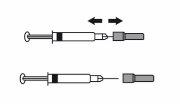
- Когда количество препарата в шприце соответствует дозе, которую вам назначили, нет необходимости регулировать дозу. Теперь вы готовы к введению инъекции.
- Когда доза зависит от вашего веса, возможно, вам придется регулировать дозу в шприце, чтобы она соответствовала назначенной дозе. В этом случае вы можете удалить излишки препарата, держа шприц вниз (чтобы сохранить пузырек воздуха в шприце) и выдавив излишки в контейнер.
- Может появиться капля на конце иглы. Если это происходит, необходимо удалить каплю, прежде чем ввести инъекцию, постукивая по шприцу с иглой, направленной вниз. Теперь вы готовы к введению инъекции.
Введение инъекции
- Держите шприц рукой, которой вы пишете (как если бы это был карандаш). Другой рукой аккуратно сожмите область, которую вы очистили на животе, между указательным пальцем и большим пальцем, чтобы образовать складку на коже.
Убедитесь, что вы держите эту складку кожи, пока продолжается инъекция.
- Держите шприц так, чтобы игла была направлена прямо вниз (вертикально под углом 90 градусов). Введите всю иглу в складку кожи.

- Нажмите на поршень большим пальцем. Таким образом, вы введете препарат в жировую ткань живота. Завершите инъекцию, используя весь препарат в шприце.
- Удалите иглу из места инъекции, потянув прямо за нее. Направьте иглу от себя и от других людей. Теперь вы можете отпустить складку кожи.
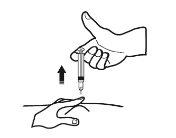
Когда вы закончите
- Чтобы избежать образования гематомы, не трите область инъекции после того, как вы ввели ее.
- Поместите использованный шприц в контейнер для острых предметов. Закройте плотно крышку контейнера и положите контейнер вне досягаемости детей. Когда контейнер будет полон, утилизируйте его так, как указал ваш врач или фармацевт.
Утилизация неиспользованного препарата и всех материалов, которые были в контакте с ним, будет осуществляться в соответствии с местными правилами.
Если вы считаете, что доза слишком высока (например, если у вас есть непредвиденная кровотечение) или слишком низка (например, если доза не кажется эффективной), проконсультируйтесь с вашим врачом или фармацевтом.
Инструкции для шприцев с устройством безопасности:
Подготовка места инъекции
- Выберите область на правой или левой стороне живота. Не менее 5 см от пупка и в сторону любого из двух боков.
Не вводите в область 5 см вокруг пупка или вокруг него, если есть рубцы или гематомы.
Чтобы вводить, чередуйте левую и правую стороны живота, в зависимости от того, где была сделана последняя инъекция.

- Вымойте руки. Очистите (не трите) область, в которой будете делать инъекцию, куском ваты с алкоголем или мылом и водой.
- Сядьте или лягте в удобное положение, чтобы вы были расслаблены. Проверьте, что вы можете видеть область, в которой будете делать инъекцию. Лучше всего на диване, кресле-качалке или в кровати с подушками.
Выбор дозы
- Аккуратно снимите колпачок с иглы шприца, потянув за него. Утилизируйте колпачок.
Перед тем, как вы введете себе, не нажимайте на поршень, чтобы удалить воздух. Это может привести к потере препарата.
После того, как вы сняли колпачок, не трогайте ничего иглой. Таким образом, вы обеспечите, что игла останется чистой (стерильной).
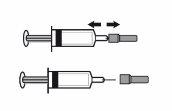
- Когда количество препарата в шприце соответствует дозе, которую вам назначили, нет необходимости регулировать дозу. Теперь вы готовы к введению инъекции.
- Когда доза зависит от вашего веса, возможно, вам придется регулировать дозу в шприце, чтобы она соответствовала назначенной дозе. В этом случае вы можете удалить излишки препарата, держа шприц вниз (чтобы сохранить пузырек воздуха в шприце) и выдавив излишки в контейнер.
- Может появиться капля на конце иглы. Если это происходит, необходимо удалить каплю, прежде чем ввести инъекцию, постукивая по шприцу с иглой, направленной вниз. Теперь вы готовы к введению инъекции.
Введение инъекции
- Держите шприц рукой, которой вы пишете (как если бы это был карандаш). Другой рукой аккуратно сожмите область, которую вы очистили на животе, между указательным пальцем и большим пальцем, чтобы образовать складку на коже.
Убедитесь, что вы держите эту складку кожи, пока продолжается инъекция.
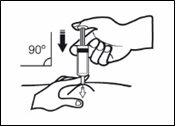 Держите шприц так, чтобы игла была направлена прямо вниз (вертикально под углом 90 градусов). Введите всю иглу в складку кожи.
Держите шприц так, чтобы игла была направлена прямо вниз (вертикально под углом 90 градусов). Введите всю иглу в складку кожи.
- Нажмите на поршень большим пальцем. Таким образом, вы введете препарат в жировую ткань живота. Завершите инъекцию, используя весь препарат в шприце.
- Удалите иглу из места инъекции, потянув прямо за нее, и держите палец на поршне. Игла должна быть направлена от вас и от других людей. Система безопасности активируется при нажатии на поршень. Защитный чехол автоматически покроет иглу и издаст слышимый щелчок, подтверждающий активацию устройства. Теперь вы можете отпустить складку кожи.
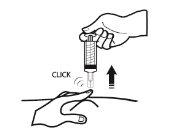
Когда вы закончите
- Чтобы избежать образования гематомы, не трите область инъекции после того, как вы ввели ее.
- Поместите использованный шприц в контейнер для острых предметов. Закройте плотно крышку контейнера и положите контейнер вне досягаемости детей. Когда контейнер будет полон, утилизируйте его так, как указал ваш врач или фармацевт.
Утилизация неиспользованного препарата и всех материалов, которые были в контакте с ним, будет осуществляться в соответствии с местными правилами.
Если вы считаете, что доза слишком высока (например, если у вас есть непредвиденная кровотечение) или слишком низка (например, если доза не кажется эффективной), проконсультируйтесь с вашим врачом или фармацевтом.
Смена антикоагулянтной терапии
- Смена Эноксапарина Рови на препараты для снижения свертываемости крови, называемые антагонистами витамина К (например, варфарин)
Ваш врач запросит анализ крови на определение параметра, называемого МНО, и скажет вам, когда необходимо прекратить лечение Эноксапарином Рови.
- Смена препаратов для снижения свертываемости крови, называемых антагонистами витамина К (например, варфарин), на Эноксапарин Рови
Прекратите использование антагониста витамина К. Ваш врач запросит анализ крови на определение параметра, называемого МНО, и скажет вам, когда необходимо начать использовать Эноксапарин Рови.
- Смена Эноксапарина Рови на лечение прямыми пероральными антикоагулянтами
Прекратите использование Эноксапарина Рови. Начните принимать прямой пероральный антикоагулянт за 0-2 часа до того, как вам должно было быть сделано следующее введение, и продолжайте как обычно.
- Смена лечения прямым пероральным антикоагулянтом на Эноксапарин Рови
Прекратите принимать прямой пероральный антикоагулянт. Не начинайте лечение Эноксапарином Рови до тех пор, пока не пройдут 12 часов после последней дозы прямого перорального антикоагулянта.
Если вы примете слишком много Эноксапарина Рови
Если вы считаете, что приняли слишком много Эноксапарина Рови или слишком мало, немедленно сообщите об этом вашему врачу, медсестре или фармацевту, даже если вы не наблюдаете признаков проблем. Если ребенок случайно ввел или проглотил Эноксапарин Рови, немедленно отвезите его в отделение неотложной помощи больницы.
В случае передозировки или случайного введения проконсультируйтесь с вашим врачом или обратитесь в отделение неотложной помощи ближайшей больницы, взяв с собой этот листок, или позвоните в Центр токсикологической информации, телефон 91 562 04 20, указав препарат и количество, введенное.
Если вы забыли принять Эноксапарин Рови
Если вы забыли сделать инъекцию, сделайте ее как можно скорее. Не принимайте двойную дозу в один и тот же день, чтобы компенсировать пропущенные дозы. Чтобы не забыть ни одной дозы, может быть полезно использовать дневник.
Если вы прекратите лечение Эноксапарином Рови
Если у вас есть другие вопросы о использовании этого препарата, проконсультируйтесь с вашим врачом или фармацевтом.
Важно, чтобы вы продолжали принимать Эноксапарин Рови до тех пор, пока ваш врач не решит прекратить лечение. Если вы прекратите его использование, может образоваться тромб, что может быть очень опасно.
4. Возможные побочные эффекты
Как и все лекарства, это лекарство может вызывать побочные эффекты, хотя не все люди испытывают их.
Как и другие подобные лекарства (лекарства для снижения свертываемости крови), Энокспарин Рови может вызывать кровотечение, которое потенциально может угрожать вашей жизни. В некоторых случаях кровотечение может быть не очевидным.
Если вы заметите любой эпизод кровотечения, который не останавливается самостоятельно, или если вы заметите признаки чрезмерного кровотечения (необычная слабость, усталость, бледность, головокружение, головная боль или необъяснимая отечность), немедленно обратитесь к вашему врачу.
Ваш врач может решить держать вас под строгим наблюдением или изменить ваше лекарство.
Прекратите лечение энокспарином и немедленно сообщите вашему врачу или медсестре, если вы испытываете любой из следующих симптомов:
- Любой признак тяжелой аллергической реакции (такой как трудности с дыханием, отек губ, рта, горла или глаз).
- Распространенная красная и чешуйчатая сыпь, с бугорками под кожей и пузырями, сопровождаемая лихорадкой. Симптомы обычно появляются в начале лечения (острый генерализованный пустулезный экзантем).
Вы должны немедленно сообщить вашему врачу
- Если у вас есть любой признак блокировки кровеносного сосуда сгустком крови, такой как:
- боль, подобная судороге, покраснение, тепло или отечность в одной из ваших ног, которые являются симптомами глубокой венозной тромбозы.
- трудности с дыханием, боль в груди, обморок или кашель с кровью, которые являются симптомами легочной эмболии.
- Если у вас есть болезненная кожная сыпь с красными точками под кожей, которые не исчезают при нажатии.
Ваш врач может запросить анализ крови, чтобы проверить количество тромбоцитов.
Общий список возможных побочных эффектов:
Очень частые (могут возникать у более 1 из 10 человек)
- Кровотечение.
- Увеличение печеночных ферментов.
Частые (могут возникать у до 1 из 10 человек)
- Если появляются синяки чаще, чем обычно. Это может быть связано с проблемой крови из-за низкого количества тромбоцитов.
- Розовые пятна на коже. Они появляются чаще в области, где вам вводили Энокспарин Рови.
- Кожная сыпь (крапивница, уртикария).
- Покраснение и зуд кожи.
- Синяк или боль в месте инъекции.
- Уменьшение количества красных кровяных клеток в крови.
- Увеличение количества тромбоцитов в крови.
- Головная боль.
Нечастые (могут возникать у до 1 из 100 человек)
- Внезапная сильная головная боль. Это может быть признаком кровоизлияния в мозг.
- Чувство чувствительности при пальпации и отечности живота. Это может быть признаком желудочного кровоизлияния.
- Красные и большие поражения кожи, неправильной формы, с или без пузырей.
- Раздражение кожи (местное раздражение).
- Вы можете заметить желтушность кожи или глаз и потемнение цвета мочи. Это может быть связано с проблемой печени.
Редкие (могут возникать у до 1 из 1000 человек)
- Тяжелая аллергическая реакция. Признаки этой реакции могут включать: кожную сыпь, проблемы с глотанием или дыханием, отек губ, лица, горла или языка.
- Увеличение калия в крови. Это более вероятно у людей с проблемами почек или диабетом. Ваш врач может проверить это с помощью анализа крови.
- Увеличение количества эозинофилов в крови. Ваш врач может проверить это с помощью анализа крови.
- Потеря волос.
- Остеопороз (болезнь, при которой кости могут ломаться чаще).
- Онемение, покалывание и слабость в мышцах (особенно в нижней части тела) после люмбальной пункции или спинальной анестезии.
- Потеря контроля над мочевым пузырем или кишечником (так что вы не можете контролировать свои потребности).
- Уплотнение или узел в месте инъекции.
Сообщение о побочных эффектах
Если вы испытываете любой побочный эффект, обратитесь к вашему врачу, фармацевту или медсестре, даже если это возможные побочные эффекты, которые не указаны в этом листке. Вы также можете сообщить о них напрямую через Систему фармаковигиланса лекарственных средств для человека: www.notificaRAM.es. Сообщая о побочных эффектах, вы можете внести свой вклад в предоставление более подробной информации о безопасности этого лекарства.
5. Хранение Энокспарина Рови
Хранить при температуре ниже 25°C. Не замораживать.
Предварительно заполненные шприцы Энокспарина Рови содержат одну дозу; утилизируйте любой неиспользованный продукт.
Держите это лекарство вне поля зрения и досягаемости детей.
Не используйте это лекарство после даты истечения срока годности, указанной на упаковке после CAD. Дата истечения срока годности - последний день месяца, указанного.
Не используйте это лекарство, если вы заметите, что шприц поврежден или продукт не прозрачный.
Лекарства не должны выбрасываться в канализацию или мусор. Поместите упаковку и лекарства, которые вам больше не нужны, в Пункт SIGRE аптеки. Спросите вашего фармацевта, как утилизировать упаковку и лекарства, которые вам больше не нужны. Таким образом, вы поможете защитить окружающую среду.
6. Содержание упаковки и дополнительная информация
Состав Энокспарина Рови
- Активное вещество - энокспарин натрия.
Каждый предварительно заполненный шприц содержит энокспарин натрия с анти-Xa активностью 12 000 МЕ (эквивалентно 120 мг) в 0,8 мл воды для инъекционных препаратов.
- Другие компоненты - вода для инъекционных препаратов.
Внешний вид продукта и содержание упаковки
Энокспарин Рови - прозрачный инъекционный раствор, бесцветный или светло-желтый, в предварительно заполненном шприце из стекла типа I, оснащенном иглой для инъекции, с или без автоматического устройства безопасности. Он представлен следующим образом:
Энокспарин Рови 12 000 МЕ (120 мг)/0,8 мл инъекционный раствор в предварительно заполненном шприце с градуировкой 1 мл.
Упаковки по 10, 30 и 50 шприцев.
Возможно, только некоторые размеры упаковок будут продаваться.
В некоторых размерах упаковок предварительно заполненный шприц может поставляться в сочетании с устройством безопасности.
Владелец разрешения на маркетинг и ответственный за производство
Владелец разрешения на маркетинг
Лаборатории Фармацевтические Рови, С.А.
Хулиан Камарильо, 35
28037 - Мадрид, Испания
Ответственный за производство
Рови Фарма Индустриал Сервисес, С.А.
Хулиан Камарильо, 35
28037 - Мадрид, Испания
Это лекарство разрешено в государствах-членах Европейского экономического пространства и в Великобритании (Северной Ирландии) под следующими названиями:
Испания: Энокспарин Рови
Германия: Энокспарин Бекат
Бельгия: Энокспарин Бекат
Польша: Лозмина
Великобритания (Северная Ирландия): Арови
Дата последнего обзора этого листка:Январь 2025
Другие источники информации
Подробная информация о этом лекарстве доступна на сайте Агентства по лекарственным средствам и медицинским изделиям Испании (AEMPS) (http://www.aemps.gob.es/)

Сколько стоит ЭНОКСАПАРИН РОВИ 12 000 МЕ (120 мг)/0,8 мл РАСТВОР ДЛЯ ИНЪЕКЦИЙ В ПРЕДНАПОЛНЕННОМ ШПРИЦЕ в Испании в 2025 году?
Средняя цена на ЭНОКСАПАРИН РОВИ 12 000 МЕ (120 мг)/0,8 мл РАСТВОР ДЛЯ ИНЪЕКЦИЙ В ПРЕДНАПОЛНЕННОМ ШПРИЦЕ в октябрь, 2025 года составляет около 86.05 евро. Финальная стоимость может зависеть от региона, конкретной аптеки и рецептурного статуса. Для точной информации лучше проверить онлайн или в ближайшей аптеке.
- Страна регистрации
- Средняя цена в аптеках86.05 EUR
- Активное вещество
- Требуется рецептДа
- Производитель
- Информация носит справочный характер и не является медицинской рекомендацией. Перед приемом любых препаратов проконсультируйтесь с врачом. Oladoctor не несет ответственности за медицинские решения, принятые на основе этого контента.
- Аналоги ЭНОКСАПАРИН РОВИ 12 000 МЕ (120 мг)/0,8 мл РАСТВОР ДЛЯ ИНЪЕКЦИЙ В ПРЕДНАПОЛНЕННОМ ШПРИЦЕФорма выпуска: ИНЪЕКЦИОННЫЙ РАСТВОР, 100 мг (10000 МЕ) эноксапарина натрия/млАктивное вещество: enoxaparinПроизводитель: Sanofi Aventis S.A.Требуется рецептФорма выпуска: ИНЪЕКЦИОННЫЙ РАСТВОР, 120 мг (12000 МЕ) /0,8 млАктивное вещество: enoxaparinПроизводитель: Sanofi Aventis S.A.Требуется рецептФорма выпуска: ИНЪЕКЦИОННЫЙ РАСТВОР, 150 мг (15000 МЕ) /1 млАктивное вещество: enoxaparinПроизводитель: Sanofi Aventis S.A.Требуется рецепт




